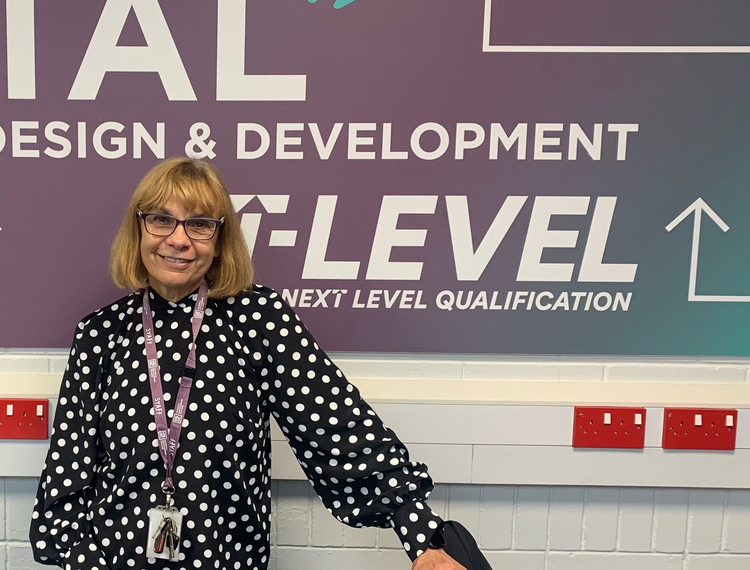T Levels: One year on – the journey so far

Nicolette Dryden @Be_HSDC is delivering the brand new Digital Production, Design and Development #TLevel. Here she discusses how she’s found her first year of teaching and why she thinks these new qualifications have the potential to boost skills in one of the UK’s key growth sectors:
This autumn marks T Levels first birthday and the beginning of year two for our first cohort of T Level students. It’s been a challenging but rewarding year for my colleagues as we navigated delivering a brand new qualification in ever changing circumstances throughout the COVID-19 pandemic.
My colleagues and I have backgrounds in software development and we have worked across various business sectors. Before we started teaching T Levels, we were very much looking forward to shaping the delivery of the qualification to reflect our own experiences in industry.
T Levels are endorsed by employers, and have been designed with them to ensure they meet the needs of industry. Every student also gets an industry placement and we’ve been determined to bring as much of our sector knowledge as possible into our classrooms too.
The new Digital Production, Design and Development T Level, which launched last year, is a great opportunity for young people to combine their studies with a minimum of 45 days of valuable industry placements. Students complete a Level 3 qualification, gain cutting-edge technical skills as well as become more employable with essential soft skills such as team working, communication, respect, problem solving and professionalism at work. We have all been so impressed by the progress our first cohort of students have made over the past year and how their learning experiences are preparing them for the world of work or future study.
Delivering a brand new course during the pandemic
It hasn’t been a straight forward journey for our students given the various COVID-19 restrictions that were in place during their first year of study. Social distancing and national guidelines did mean we had to undertake remote learning at various points. Fortunately, my colleague was able to set up virtual cloud machines so students could access processing power and application software required for the course at home. We also used Google Collab which is great for sharing code and testing new concepts in contained cells, as well as integrating with Google drive and classroom. Ultimately, despite some hurdles, we were able to successfully move all of our teaching online and adapt well to delivering the course remotely.
During the first year of delivery, we tested our students early and often so they became familiar with the different styles of questions and were comfortable in exam conditions. When March 2021 arrived we were able to return to the classroom and continued testing students rigorously to prepare for their mocks. This and previous testing proved worthwhile and beneficial for the students and we have seen their confidence and skills grow immensely.
Entering Year 2
We are now into the first term of year two with students reinforcing, extending and honing their programming skills ready for the Occupational Specialism project assessment. We are reaping the rewards of taking a project based approach in the first year as students are already familiar with the ideas and concepts behind the Occupational Specialism which is a massive project assessed in a 67hr controlled assessment window taking place between February and May 2022.
We planned for our students to take the core exams at the end of the first year, so that they could solely focus on the Occupational Specialism this teaching term. Due to the pandemic, these exams were taken as mocks, and TAGs provided. Having the core grades awarded in the summer has been a real plus especially as the assessment window in February is fast approaching.
As we work our way through year two, as expected, the new first year students are benefitting from our experience of the previous year and the second years (including ourselves) are continually learning, adapting and researching new ways of doing things, trying to keep ahead of the curve.
Looking to the future
I’ve currently only got one female student in my class Chloe who has excelled this year, but we need more women to join the industry to represent the female population and design tech in a way that suits women. Currently only 3% of women say a career in technology is their first choice and only 16% of women have had a career in technology suggest to them.
I did a degree in computer science in the 1980s and there were 3 women including myself and 60 men in the class. It was a really fun environment to work in, but I really want more young women to come join the industry because there are so many opportunities for them. The T Level in Digital Production, Design and Development is a brilliant first step into the industry and I would encourage all students interested in the field to explore their choices.
Over the past year we have seen students grow to appreciate how everything they are learning, whether it is legal regulations, data privacy, business sector understanding, emerging technology, cloud computing needs consideration when developing software. Our T Level students have a wide range of options open to them when they finish their courses – they can go straight into work, further training or study. We’re all looking forward to seeing our first cohort of students progress onwards and upwards as they work their way through their second year.
Nicolette Dryden, Digital Computing & IT teacher, Havant and South Down College (HSDC) in Hampshire











Responses